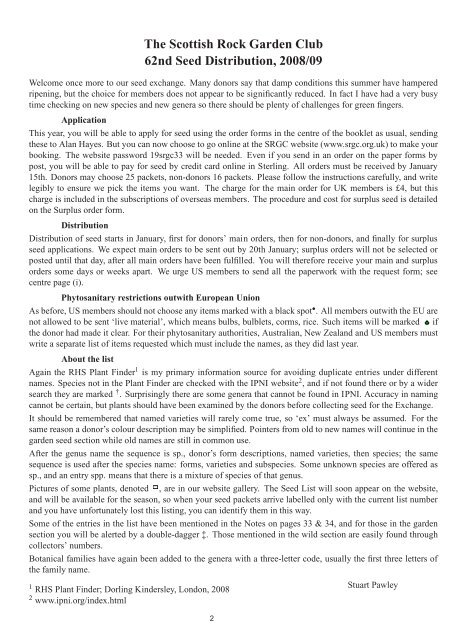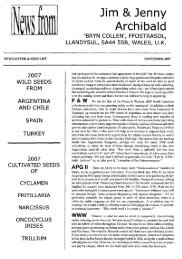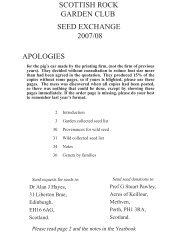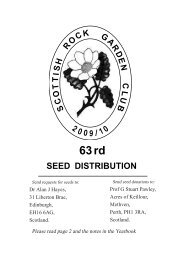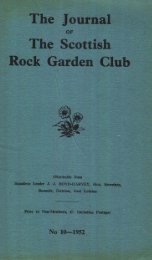DISTRIBUTION SEED - the Scottish Rock Garden Club
DISTRIBUTION SEED - the Scottish Rock Garden Club
DISTRIBUTION SEED - the Scottish Rock Garden Club
You also want an ePaper? Increase the reach of your titles
YUMPU automatically turns print PDFs into web optimized ePapers that Google loves.
The <strong>Scottish</strong> <strong>Rock</strong> <strong>Garden</strong> <strong>Club</strong><br />
62nd Seed Distribution, 2008/09<br />
Welcome once more to our seed exchange. Many donors say that damp conditions this summer have hampered<br />
ripening, but <strong>the</strong> choice for members does not appear to be significantly reduced. In fact I have had a very busy<br />
time checking on new species and new genera so <strong>the</strong>re should be plenty of challenges for green fingers.<br />
Application<br />
This year, you will be able to apply for seed using <strong>the</strong> order forms in <strong>the</strong> centre of <strong>the</strong> booklet as usual, sending<br />
<strong>the</strong>se to Alan Hayes. But you can now choose to go online at <strong>the</strong> SRGC website (www.srgc.org.uk) to make your<br />
booking. The website password 19srgc33 will be needed. Even if you send in an order on <strong>the</strong> paper forms by<br />
post, you will be able to pay for seed by credit card online in Sterling. All orders must be received by January<br />
15th. Donors may choose 25 packets, non-donors 16 packets. Please follow <strong>the</strong> instructions carefully, and write<br />
legibly to ensure we pick <strong>the</strong> items you want. The charge for <strong>the</strong> main order for UK members is £4, but this<br />
charge is included in <strong>the</strong> subscriptions of overseas members. The procedure and cost for surplus seed is detailed<br />
on <strong>the</strong> Surplus order form.<br />
Distribution<br />
Distribution of seed starts in January, first for donors’ main orders, <strong>the</strong>n for non-donors, and finally for surplus<br />
seed applications. We expect main orders to be sent out by 20th January; surplus orders will not be selected or<br />
posted until that day, after all main orders have been fulfilled. You will <strong>the</strong>refore receive your main and surplus<br />
orders some days or weeks apart. We urge US members to send all <strong>the</strong> paperwork with <strong>the</strong> request form; see<br />
centre page (i).<br />
Phytosanitary restrictions outwith European Union<br />
As before, US members should not choose any items marked with a black spot • . All members outwith <strong>the</strong> EU are<br />
not allowed to be sent ‘live material’, which means bulbs, bulblets, corms, rice. Such items will be marked if<br />
<strong>the</strong> donor had made it clear. For <strong>the</strong>ir phytosanitary authorities, Australian, New Zealand and US members must<br />
write a separate list of items requested which must include <strong>the</strong> names, as <strong>the</strong>y did last year.<br />
About <strong>the</strong> list<br />
Again <strong>the</strong> RHS Plant Finder 1 is my primary information source for avoiding duplicate entries under different<br />
names. Species not in <strong>the</strong> Plant Finder are checked with <strong>the</strong> IPNI website 2 , and if not found <strong>the</strong>re or by a wider<br />
search <strong>the</strong>y are marked † . Surprisingly <strong>the</strong>re are some genera that cannot be found in IPNI. Accuracy in naming<br />
cannot be certain, but plants should have been examined by <strong>the</strong> donors before collecting seed for <strong>the</strong> Exchange.<br />
It should be remembered that named varieties will rarely come true, so ‘ex’ must always be assumed. For <strong>the</strong><br />
same reason a donor’s colour description may be simplified. Pointers from old to new names will continue in <strong>the</strong><br />
garden seed section while old names are still in common use.<br />
After <strong>the</strong> genus name <strong>the</strong> sequence is sp., donor’s form descriptions, named varieties, <strong>the</strong>n species; <strong>the</strong> same<br />
sequence is used after <strong>the</strong> species name: forms, varieties and subspecies. Some unknown species are offered as<br />
sp., and an entry spp. means that <strong>the</strong>re is a mixture of species of that genus.<br />
Pictures of some plants, denoted , are in our website gallery. The Seed List will soon appear on <strong>the</strong> website,<br />
and will be available for <strong>the</strong> season, so when your seed packets arrive labelled only with <strong>the</strong> current list number<br />
and you have unfortunately lost this listing, you can identify <strong>the</strong>m in this way.<br />
Some of <strong>the</strong> entries in <strong>the</strong> list have been mentioned in <strong>the</strong> Notes on pages 33 & 34, and for those in <strong>the</strong> garden<br />
section you will be alerted by a double-dagger ‡. Those mentioned in <strong>the</strong> wild section are easily found through<br />
collectors’ numbers.<br />
Botanical families have again been added to <strong>the</strong> genera with a three-letter code, usually <strong>the</strong> first three letters of<br />
<strong>the</strong> family name.<br />
1 RHS Plant Finder; Dorling Kindersley, London, 2008<br />
2 www.ipni.org/index.html<br />
2<br />
Stuart Pawley


